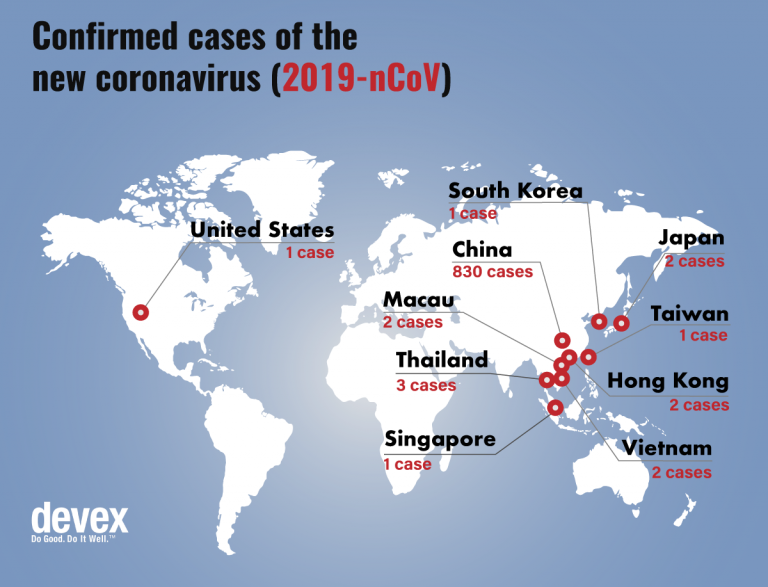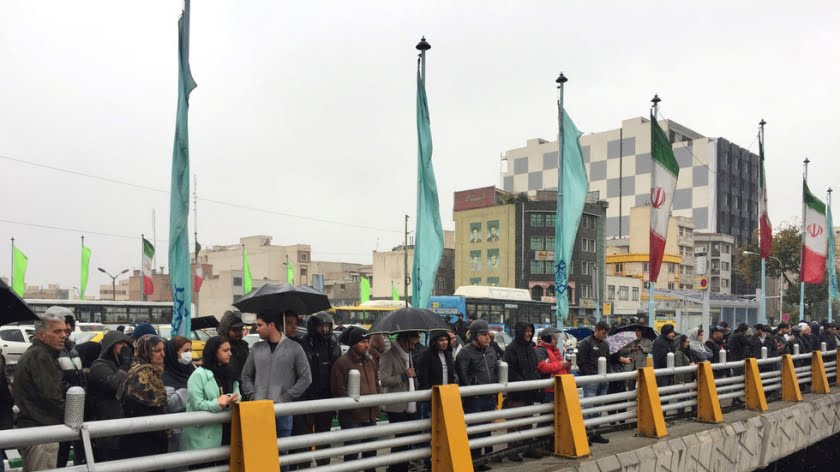China’s New Coronavirus: An Examination of the Facts
The Western mass media have discussed the new corona virus that began in the city of Wuhan in Central China but, apart from repetitive small details and the inevitable China-bashing, not much light has been shed on the circumstances. My initial commentary here is composed from a medley of nearly 100 Western news reports, primarily ABC, CBS, CNN, AFP, and from some Chinese media. Officially called the novel coronavirus (2019-nCoV), the contagion is a respiratory illness, a new type of viral pneumonia, in the same family of infections as SARS and MERS.
At the time of writing, Chinese health authorities announced 830 confirmed cases caused by this virus in 29 provincial-level regions in the country, resulting so far in 25 deaths primarily among the elderly who had been suffering serious prior medical conditions and were perhaps in weakened physical states. A few cases have been reported in other countries, Thailand, Korea, Singapore, Vietnam, the US, Japan, all of which involved ethnic Chinese who had traveled to Wuhan. The virus initially showed no signs of spreading between humans, but then may have mutated with 15 medical workers in Wuhan apparently contracting the pathogen from other victims. It still remains unclear how easy it is to contract it from another infected individual.

The initial symptoms were mild, which permitted many people to travel before stronger symptoms were detected. The first occurrences in December thus appeared to be of minor concern. The incubation period has not been definitively stated but, once infections began, the spread was surprisingly rapid after the first case was confirmed on December 31: on January 3, 44 cases; January 21, 225 cases, January 24, 830 cases. Local medical authorities have said the true extent of the Wuhan coronavirus is unclear, and the early official figures may have been an underestimation since the mild symptoms and delayed onset meant infections may have been undetected.
All the evidence suggests the Chinese authorities acted effectively as soon as they realised the danger they might be facing. Medical authorities immediately declared the outbreak, and within a week they had identified the pathogen and also determined and shared the genome sequence with the WHO and other parties, a sufficiently speedy response that earned praise from the WHO and scientists around the world.
Remembering the SARS troubles, they did much more. In most large centers in the country, all sports venues, theaters, museums, tourist attractions, all locations that attract crowds, have been closed, as have all schools. All group tours have been cancelled. Not only the city of Wuhan but virtually the entire province of Hubei has been locked down, with all trains, aircraft, buses, subways, ferries, grounded and all major highways and toll booths closed. Thousands of flights and train trips have been cancelled until further notice. Some cities like Shanghai and Beijing are conducting temperature tests on all roadways leading into the cities. In addition, Wuhan is building (in five days) a portable hospital of 25,000 square meters to deal with the infected patients. As well, Wuhan has asked citizens to neither leave nor enter the city without a compelling reason, and all are wearing face masks.
The scale of the challenge of implementing such a blockade is immense, comparable to closing down all transport links for a city five times the size of Toronto or Chicago, two days before Christmas. These decisions are unprecedented, but testify to the determination of the authorities to limit the spread and damage of this new pathogen. They not only address the gravity of the situation but also the seriousness of consideration for the public health, unfortunate and difficult decisions since the holiday is being destroyed for hundreds of millions of people. Most public entertainment has been cancelled, as have tours, and many weddings as well. The damage to the economy during this most festive of all periods, will also be enormous. Hong Kong will suffer severely in addition to all its other troubles, since visits from Mainland Chinese typically support much of its retail economy during this period.
The Chinese New Year is the most important festival for Chinese. Saturday, January 25, is the first day of the Lunar New Year, a festive period that typically sees the largest mass-movement of people on the planet as Chinese flock back to their hometowns to be with relatives. No health authority has ever tackled the challenge currently faced by China, as the country grapples with a new coronavirus just as hundreds of millions prepare to travel.
And of course the Western media had a field day of schadenfreude. CNN published a report – a bit too gleefully, I thought – on the potential damage to China’s economy: (1)
“China’s economy is slumping and the country is still suffering the effects of the trade war with America. An outbreak of a new and deadly virus is the last thing it needs. The Wuhan coronavirus has already roiled Chinese markets and thrown plans for the upcoming Lunar New Year holiday into chaos for millions of people. The world’s second biggest economy grew at its slowest pace in nearly three decades last year as it contended with rising debt, cooling domestic demand and US tariffs, many of which remain in place despite a recent truce. Beijing is worried about unemployment, too, and has announced a wave of stimulus measures in recent weeks aimed at preventing mass layoffs. . . The Wuhan coronavirus outbreak could spark widespread fear and spur people to hunker down and avoid going outside. That kind of behavior would deal a huge blow to the service sector, which now accounts for about 52% of the Chinese economy.” [And so on . . .]
The Western media have already staked out their claim to the fundamentals, all media sources claiming the virus was transferred to humans from animals or seafood. The media have added fuel to the fire by claiming the virus emerged from “illegally traded wildlife” in a market “where offerings reportedly include wild animals that can carry viruses dangerous to humans”, and that this virus “jumped into the human population from an infected animal”. Chinese officials stated that the virus appears to have originated at a seafood market in Wuhan, though the actual origin has not been determined nor stated by the authorities, and is still an open question perhaps primarily since viruses seldom jump species barriers without human assistance.
While there is no evidence of biowarfare, a virus outbreak in the city of Wuhan immediately prior to the Chinese New Year migration could potentially have dramatic social and economic repercussions. Wuhan, with a population of about 12 million, is a major transport hub in Central China, particularly for the high-speed train network, and with more than 60 air routes with direct flights to most of the world’s major cities, as well as more than 100 internal flights to major Chinese cities. When we add this to the Spring Festival travel rush during which many hundreds of millions of people travel across the country to be with their families, the potential consequences for the entire country are far-reaching.
Comparison with SARS
This is a novel Coronavirus (2019-nCoV), an entirely new strain related to the MERS (MERS-CoV) and the SARS (SARS-CoV) viruses, though early evidence suggests it is not as dangerous.
SARS was proven to be caused by a strain of the coronavirus, a large family of mostly harmless viruses also responsible for the common cold, but SARS exhibited characteristics never before observed in any animal or human virus, did not by any means fully match the animal viruses mentioned above, and contained genetic material that still remains unidentified – similar to this new corona virus in 2019.
Virologist Dr. Alan Cantwell wrote at the time that “the mysterious SARS virus is a new virus never before seen by virologists. This is an entirely new illness with devastating effects on the immune system, and there is no known treatment.” Dr. Cantwell also noted that the genetic engineering of coronaviruses has been occurring in both medical and military labs for decades. He wrote that when he searched in PubMed for the phrase “coronavirus genetic engineering”, he was referred to 107 scientific experiments dating back to 1987. To quote Dr. Cantwell:
“I quickly confirmed scientists have been genetically engineering animal and human coronaviruses to make disease-producing mutant and recombinant viruses for over a decade. No wonder WHO scientists identified the SARS/coronavirus so quickly. Never emphasised by medical news writers is the fact that for over forty years scientists have been “jumping species” with all sorts of animal and human viruses and creating chimera viruses (viruses composed from viruses of two different species). This unsupervised research produces dangerous man-made viruses, many of which have potential as bioweapons. Certainly SARS has the hallmarks of a bioweapon. After all, aren’t new biological warfare agents designed to produce a new disease with a new infectious agent? As in prior military experiments, all it might take … to spread SARS is an aerosol can . . .” (2) (3) (4)
Almost immediately upon receiving the genome sequence, several Russian scientists suggested a link between SARS and biowarfare. Sergei Kolesnikov, a member of the Russian Academy of Medical Sciences, said the propagation of the SARS virus might well have been caused by leaking a combat virus grown in bacteriological weapons labs. According to a number of news reports, Kolesnikov claimed that the virus of atypical pneumonia (SARS) was a synthesis of two viruses (of measles and infectious parotiditis or mumps), the natural compound of which was impossible, that this mix could never appear in nature, stating, “This can be done only in a laboratory.” (5) And Nikolai Filatov, the head of Moscow’s epidemiological services, was quoted in the Gazeta daily as stating he believed SARS was man-made because “there is no vaccine for this virus, its make-up is unclear, it has not been very widespread and the population is not immune to it.” (6) (7)
It wasn’t widely reported, but it seems the final conclusion of the Chinese biochemists was the same, that the SARS virus was man-made. This conclusion wasn’t a secret, but neither was it promoted to the international media since they would simply have used the claim to heap scorn on China, dismissing this as a paranoid conspiracy theory. The Western media totally ignored this aspect, except for ABC news who reported that the SARS “Mystery Virus” was possibly “a Chinese bio-weapon that accidentally escaped the laboratory”. Nice of ABC to notice, but their story, if true, would be the first example of a nation creating and releasing a race-specific biological weapon designed to attack exclusively itself.
Notable is that while SARS spread to about 40 countries, the infections in most countries were few and deaths almost zero, and it was exclusively (or almost exclusively) Chinese who were infected, those in Hong Kong most seriously, with Mainland China suffering little by comparison. The SARS virus apparently much preferred Chinese to Caucasians, though it did attack Vietnamese health care workers (who may be similar to Chinese in their susceptibility). This appears to be precisely the case with this new virus, in that all the infected persons are Chinese. News reports speak of infections appearing in Thailand or the US, but those (at least to date of writing) were all Chinese who had been to Wuhan. There have been no cases so far of infected Caucasians.
As with SARS, this new virus appears to be tightly-focused and race-specific to Chinese. We might in other circumstances pass this off as an unfortunate coincidence but for some major circumstantial events that serve to alter our focus. One of these is the history of American universities and NGOs having come into China in recent years to conduct biological experiments that were so illegal as to leave the Chinese authorities enraged. This was particularly true when it became known that Harvard University had surreptitiously proceeded with experiments in China that had been forbidden by the authorities years earlier, where they collected many hundreds of thousands of Chinese DNA samples and then left the country. (8) (9) (10) (11) (12)
The Chinese were furious to learn that Americans were collecting Chinese DNA. The government intervened and prohibited the further export of any of the data. The conclusion at the time was that the ‘research’ had been commissioned by the US military with the DNA samples destined for race-specific bio-weapons research.
In a thesis on Biological Weapons, Leonard Horowitz and Zygmunt Dembek stated that one clear sign of a genetically-engineered bio-warfare agent was a disease caused by an uncommon (unusual, rare, or unique) agent, with lack of an epidemiological explanation. I.e. no clear idea of source. They also mentioned an “unusual manifestation and/or geographic distribution”, of which race-specificity would be one. (13)
Recent disease outbreaks that would seem to possibly qualify as potential bio-warfare agents are AIDS, SARS, MERS, Bird Flu, Swine Flu, Hantavirus, Lyme Disease, West Nile Virus, Ebola, Polio (Syria), Foot and Mouth Disease, the Gulf War Syndrome and ZIKA. And in fact thousands of prominent scientists, physicians, virologists and epidemiologists on many continents have concurred that all these viruses were lab-created and their release deliberate. The recent swine flu epidemic in China has the hallmarks as well, with circumstantial evidence of the outbreak raising only questions.
There was another curiosity in this case, in that additional to the usual criticisms of China being inactive or secretive, several US media replicated accusations from “a senior US State Department official” claiming Washington was “still concerned” about transparency in the Chinese government on the Wuhan coronavirus. Other articles claimed the US CDC was “concerned that Chinese health officials have still not released basic epidemiological data about the Wuhan coronavirus outbreak, making it more difficult to contain the outbreak.” There is no substantial reason that officials at any level of the US State Department should concern themselves with a virus outbreak in a foreign country.
Their criticisms were surprisingly detailed, demanding specifics on the number of infections directly from contact with the Wuhan market, the number of person-to-person infections, the precise incubation period from exposure to the onset of symptoms, the point at which persons become contagious. The questions were presented in benevolent terms of helping the Chinese medical authorities deal with the virus, though it was already self-evident China had no need to be lectured on such basics. I must say my sense from reading the articles in question was that the Americans were fishing for something unstated, very possibly the crucial details of their handiwork.
As of the date of writing, details are still too scarce to form definitive conclusions but, in every such case, once the smoke clears there are many unanswered questions that challenge the official Western narrative, but it’s old news and the media have already staked out their ground so the matter dies in the Western public mind, but not in China.
Notes
(1) The Wuhan virus is the last thing China’s economy needs …
https://www.cnn.com/2020/01/23/economy/wuhan-coronavirus-china-economy/index.html
(2) u2.lege.net/whale.to/c/cantwell_alan.html
(3) https://medicalveritas.org/rigged-science-man-made-aids
(4) https://www.amazon.com/AIDS-Doctors-Death-Inquiry-Epidemic/dp/0917211251
(5) https://rense.com/general37/manmade.htm
(6) https://www.veteranstoday.com/2020/01/21/new-improved-sars-bioweapon-tested-in-china
(7) https://rense.com/general37/bio.htm
(8) The Harvard case of Xu Xiping: exploitation of the people, scientific advance, or genetic theft?
Margaret Sleeboom; Amsterdam School of Social Science Research, University of Amsterdam and International Institute for Asian Studies, University of Leiden, The Netherlands
Routlege; Taylor & Francis group; New Genetics and Society, Vol. 24, No. 1, April 2005
(9) http://ahrp.org/article-30/
(10) http://www1.chinadaily.com.cn/en/doc/2003-09/25/content_267233.htm
(11) http://www.ahrp.org/ethical/ChinaDaily092503.php
(12) http://www1.chinadaily.com.cn/en/doc/2003-09/25/content_267233.htm
(13) Medical Aspects of Biological Warfare; https://repository.netecweb.org/items/show/325
By Larry Romanoff
Source: Global Research








Reblogged this on Wake Up To The Truth.
Good article. When I heard about the outbreak, I was suspicious that the US television network gave so little information. The outbreak was hyped up, as if this is a deadly disease, but I looked up coronavirus in my medical texts and found it is common and the cause of about 10-20% of common colds. It only becomes dangerous or deadly in immuno-compromised people, or those with chronic respiratory problems. I suspect that as with all infectious diseases, it is more virulent in the very young, the very old, and those with other medical problems, like malnutrition. I’ve been to China (in 1998) and was struck by how bad the air pollution is in the major cities; this probably plays a role in susceptibility to respiratory infection.
Maybe, as you say, this is a laboratory-created virus intended for biological warfare. I wouldn’t put it past the CDC, which with the FDA, sounds alarms on a regular basis about the diseases that crop up suddenly and under suspicious circumstances. The US certainly has it in for China these days. Is this yet another method of fighting trade wars?
On a related note, I’ve been following the FDA’s periodic food scares since 2007. There seems to be a pattern of a couple of suspicious outbreaks, followed by questionable identification of the source–often privately-owned producers or packagers–recall of all its products or massive destruction of the animals that supposedly carry the disease–all at times when the crops are just being harvested or just before holidays, like turkeys before Thanksgiving and Christmas.
Then, there is no follow-up, except that the price for related products go up, and Big Food (which is never implicated) reaps the benefits.